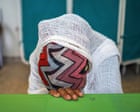
Recent global and national events have brought to light critical issues, from the harrowing accounts of human rights violations in Tigray to aviation safety concerns following a tragic crash in Washington, DC. This article aims to distill these pressing matters into an informative and mindful narrative, encouraging understanding and awareness.
In the war-torn region of Tigray, a comprehensive report by Physicians for Human Rights and the Organization for Justice and Accountability in the Horn of Africa (OJAH) sheds light on unspeakable acts that have left deep scars on communities. The report draws attention to the systematic use of sexual violence as a weapon of war by Ethiopian and Eritrean forces, detailing mass rapes, sexual slavery, and forced pregnancies. These findings were meticulously compiled through the medical records of over 500 patients, alongside surveys and interviews with hundreds of healthcare workers and community leaders. This extensive documentation underscores the gravity of the situation, categorizing these acts as crimes against humanity.
The use of such extreme measures has raised urgent calls for accountability and action, as survivors continue to grapple with the psychological and physical ramifications. The report’s revelations are poignant reminders of the resilience of the affected communities and the vital need for global solidarity and intervention to prevent further atrocities. The ongoing conflict and the lack of accountability highlight the complexity of the situation, demanding attention and resolve from international bodies dedicated to human rights and peace-building.
Meanwhile, in the United States, the realm of aviation safety has come under scrutiny following an unfortunate collision in Washington, DC. A passenger jet and a US Army helicopter reportedly collided near Ronald Reagan Washington National Airport earlier this year. Experts investigating the incident have pointed out the potential role that night-vision goggles played in the mishap. According to testimony presented to the National Transportation Safety Board (NTSB), these goggles, while typically enhancing vision in low-light conditions, may have hindered the pilots’ ability to see the plane’s colored lights, obscuring crucial directional cues and limiting peripheral vision.
This tragic event has spurred discussions about the current safety protocols and the technology used in military aviation. The findings highlight the need for ongoing evaluation and adaptation of equipment to ensure both military and civilian safety. It serves as a poignant reminder of the intricate balance needed between technological advancement and human capability, emphasizing the continuous journey of learning and improving to prevent future incidents.
Together, these situations reflect broader themes of accountability and safety across different contexts. The Tigray report calls for international response to prevent continued human suffering and bring perpetrators to justice, while the aviation incident prompts re-evaluation of existing safety measures and technologies.
While the issues presented carry their inherent gravity, they also offer a space for collective reflection and action. They invite stakeholders at all levels—from international organizations to individual advocates—to come together with empathy and determination, striving towards a future where such significant legal and safety concerns are adequately addressed and resolved.
Source: {link}
